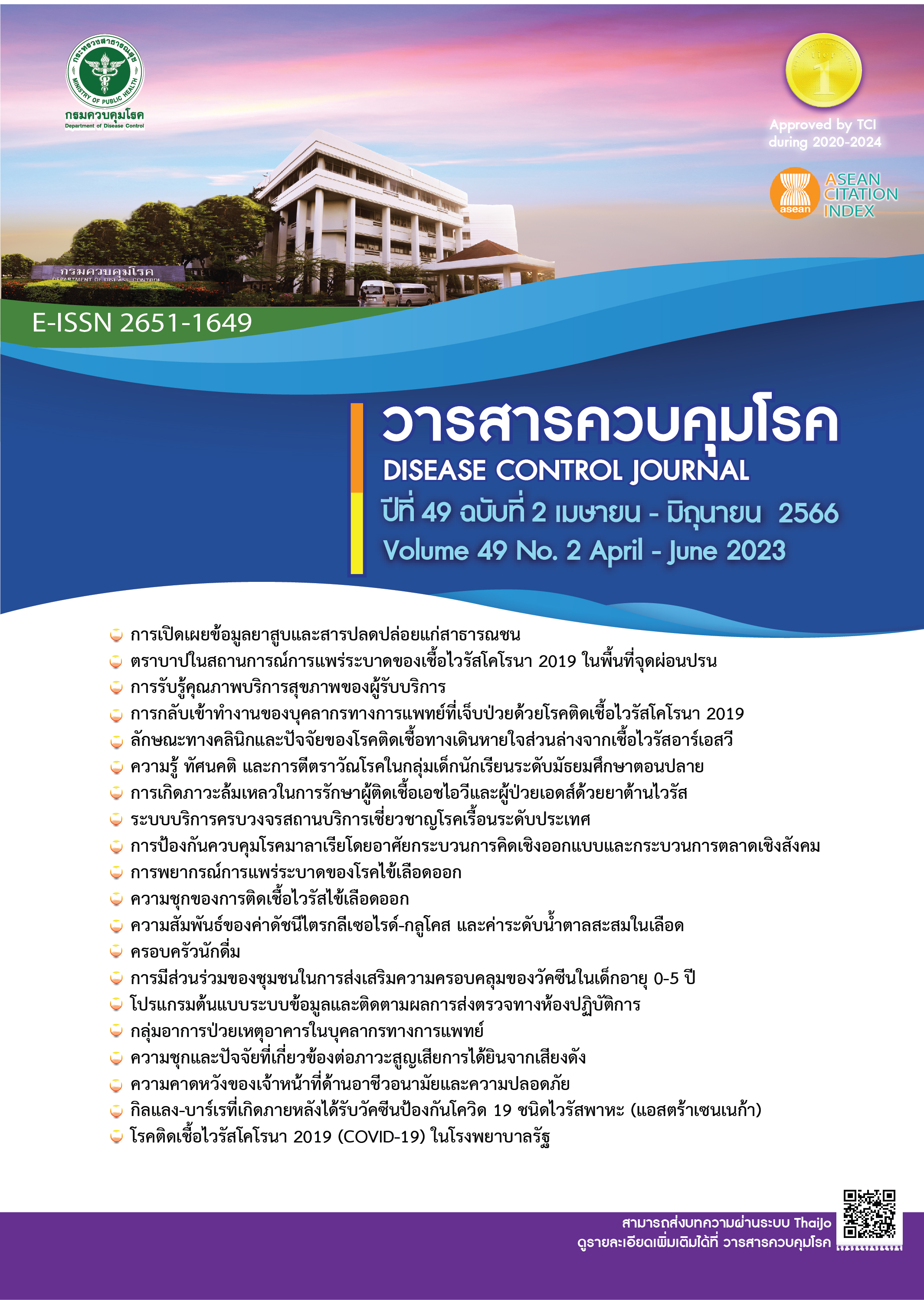Prevalence and factors associated with noise-induced hearing loss among noise-exposed workers in Chonburi Hospital
DOI:
https://doi.org/10.14456/dcj.2023.37Keywords:
noise-induced hearing loss, noise exposure, sensorineural hearing loss, hearing loss, noise-exposed workersAbstract
This study was aimed to investigate the prevalence and factors associated with noise-induced hearing loss among noise-exposed workers in Chonburi hospital. The study design was a cross-sectional descriptive study, which was conducted among all 102 noise-exposed workers. The questionnaires validated by the experts were used to collect data. The data obtained from participants were used in combination with audiogram results acquired from the same group of participants in 2021. The data were analyzed using descriptive statistics and multiple logistic regression. Findings indicated that the prevalence of noise-induced hearing loss was 47.6%. The factors which are statistically significantly related to noise-induced hearing loss included history of smoking (adjusted OR=4.10, 95%CI 1.05-16.02), history of noise exposure (adjusted OR=23.64, 95%CI 2.09-267.92), and frequency of the use of personal protective equipment (adjusted OR=0.65, 95%CI 0.01-0.58). The results revealed that noise-induced hearing loss has remained the occupational health problem among noise-exposed workers in Chonburi hospital -- which should be solved. To effectively address the issue, there should be a plan for health promotion and hearing loss prevention among high-risk workers.
Downloads
References
World Health Organization. Deafness and hearing loss [Internet]. 2012 [cited 2021 Oct 23]. Available from: https://www.who.int/health- topics/hearing-loss#tab=tab_1
World Health Organization. Addressing the rising prevalence of hearing loss [Internet]. 2018 [cited 2021 Oct 23]. Available from: https://apps.who.int/iris/bitstream/handle/10665/260336/9789241550260-eng.pdf
Ratanarak A, Intornpintuwat M, Wansaen K, Sakulku P. State of occupational noise induce hearing loss situation in Thailand and other countries. KKU J Public Health Res. 2017;10(1):1-10. (in Thai)
Division of occupational and environmental diseases (TH). Status report of diseases and health disasters from occupational and environment year 2018 [Internet]. 2019 [cited 2021 Oct 23]. Available from: http://envocc.ddc.moph.go.th/uploads/situation2/2561/2561_01_envocc_situation.pdf (in Thai)
Wongsuwan K, Rattanaarun K, Kittiwannawong K. Prevalence of noise-induced hearing loss in workers with noise exposure in Panyananthaphikkhu Chonprathan medical center, Srinakharinwirot university. J Health Sci Med Res. 2019;37(2):81-92.
Fuengfoo P, Rungsiri C, Boonplian W, Nukit S, Sanguanuan S, Harnchumpol P, et al. Noise-induced hearing loss in machinery laundry of Phramongkutklao hospital and occupational health management. Royal Thai Army Medical Journal. 2013;66(4):161-8. (in Thai)
Akkaratham K. Hearing loss among central supply employees in Sanpatong hospital, Chiang Mai province. Lanna Public Health Journal. 2006;4(3):385-91. (in Thai)
Raksri T, Tuntiseranee P, Chayarpham S. A three-year follow up study (1998-2001) of noise-induced hearing loss and occupational noise exposure among workers in Songklanagarind hospital. Songkla Med J. 2004;22(2):351-61. (in Thai)
Ritngam A. Noise-induced hearing loss prevention: role of occupational health nurse. Journal of Public Health Nursing. 2018;32(2):223-38. (in Thai)
Coles RR, Lutman ME, Buffin JT. Guidelines on the diagnosis of noise-induced hearing loss for medicolegal purposes. Clin Otolaryngol Allied Sci. 2000;25(4):264-73.
Chaempattanakit P. The prevalence rate and risk factors of noise induced hearing loss among occupational noise exposure workers in Pakchong Na Na hospital. Reg 11 Med J. 2018;32(2):981-92. (in Thai)
Worker’s Compensation Fund Social Security Office. Situation of work-related injuries and illnesses 2016-2020 [Internet]. 2021 [cited 2021 Oct 23]. Available from: https://www.sso.go.th/wpr/assets/upload/files_storage/sso_th/5ebe42693bf27ca624d2a14a89f99223.pdf (in Thai)
Arjkaew K, Pruktharathikul V, Chaiklieng S. Prevalence of hearing loss and noise exposure among workers in air conditioning and refrigeration components manufacturing. The Public Health Journal of Burapha University. 2020;15(1):1-13. (in Thai)
Chernthon P, Chanprasit C, Songkham W. Hearing capacity and use of hearing protection devices among wood carving informal workers. Nursing J. 2017;44(4):105-17. (in Thai)
Li X, Rong X, Wang Z, Lin A. Association between smoking and noise-induced hearing loss: a meta-analysis of observational studies. Int J Environ Res Public Health. 2020;17(4):1201-14.
Occupational Health and Environment Academic Development Center, Samut Prakan Province. Guidelines for surveillance occupational noise- induced hearing loss; 2020. (in Thai)
Zhou J, Shi Z, Zhou L, Hu Y, Zhang M. Occupational noise-induced hearing loss in China: a systematic review and meta-analysis. BMJ Open [Internet]. 2020 Sep 1;10(9):e039576. [cited 2021 Oct 23]. Available from: https://bmjopen.bmj.com/content/bmjopen/10/9/e039576.full.pdf
Rubak T, Kock SA, Koefoed-Nielsen B, Bonde JP, Kolstad HA. The risk of noise-induced hearing loss in the Danish workforce. Noise Health. 2006;8(31):80-7.
Downloads
Published
How to Cite
Issue
Section
License
Copyright (c) 2023 Disease Control Journal

This work is licensed under a Creative Commons Attribution-NonCommercial-NoDerivatives 4.0 International License.
Articles published in the Disease Control Journal are considered as academic work, research or analysis of the personal opinion of the authors, not the opinion of the Thailand Department of Disease Control or editorial team. The authors must be responsible for their articles.






